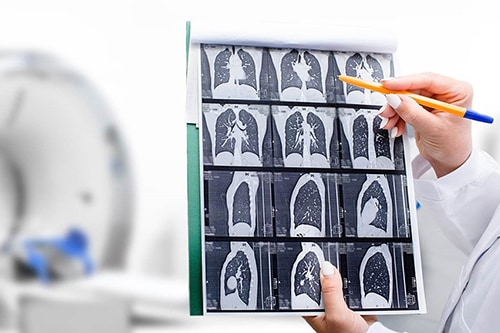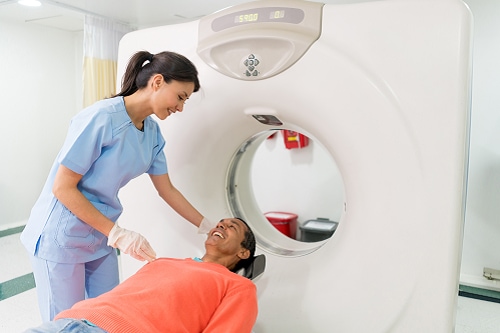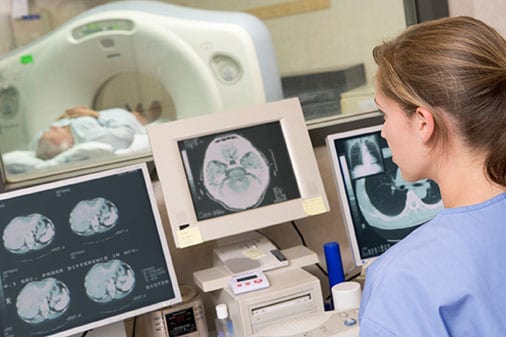Computed Tomography (CT) Scans
Computed tomography, or CT, scans are medical imaging tests that use ionizing radiation to create cross-sectional (slices) pictures inside selected areas of the body from different angles. The images can show internal organs, blood vessels, soft tissues, and bones. CT scans combine a series of x-ray (radiography) images into a three-dimensional picture.
What You Should Know
Your healthcare provider may ask for a CT scan to detect, diagnose, or plan treatment for a particular disease or injury.
Common uses of CT scan include checking for:
- Tumors
- Infections
- Blood clots
- Internal bleeding
Find information on special considerations for pregnant women and children.
We all are exposed to ionizing radiation every day from the natural environment but added exposures can increase the possibility of developing cancer later in life. Your healthcare provider will recommend a CT scan when the benefits to your health outweigh the risk.
Talk to your healthcare provider and radiologist (medical professional that performs tests using radiation) if you have any questions or concerns to decide on the best options for you.
What To Expect
Before the procedure

The radiologist will explain the procedure and ask you if you have any questions. Some CT procedures may use a contrast dye which allows healthcare providers to see specific organ(s). You may be asked to drink the contrast dye or you may receive it in an intravenous (IV) line in the hand or arm.
Make sure to tell your healthcare provider and the radiologist doing the test if you:
- Have ever had an allergic reaction to any contrast dye.
- Are pregnant or suspect that you may be pregnant.
During the Procedure

- You will be asked to remove any clothing and jewelry that may interfere with the procedure.
- You will be asked to lie very still on a table while it moves slowly through an x-ray machine (like a tube) taking images of your body.
- The computer will organize the x-ray information to show the internal structures in detail.
Additional Benefits and Possible Health Effects of CT Scans
CT scans usually require more exposure to radiation than common x-rays because they use a series of x-ray images. Increased exposure means a slightly higher risk of possible short-term and long-term health effects. However, CT scans provide your healthcare provider with more detailed images that can include parts of the body that may not be seen on common x-ray images. Talk to your healthcare provider to decide what type of imaging will use the least amount of radiation while providing the information and details needed for your diagnosis.
Related Links
ACR
CRCPD State Contacts
ASRT
FDA
Image Gently
- What Parents should Know about Medical Radiation Safety [PDF – 430 kb]
- Educational Materials on Pediatric Imaging
EPA
- RadTown USA Medical X-Rays
- Radiation Protection Guidance for Diagnostic and Interventional X-Ray Procedures
US National Library of Medicine
Most people have had one or more medical imaging tests that use ionizing radiation. The type of imaging procedure that your doctor may suggest will depend on your health concern and the part of the body that is being examined. Some other common examples of imaging tests include:
- X-rays (including dental x-rays, chest x-rays, spine x-rays)
- Fluoroscopy
If your doctor suggests a CT scan or other medical imaging procedures you should consider the following:
- Medical imaging procedures should be performed only when necessary.
- The U.S. Food and Drug Administration (FDA) recommends discussing the benefits and risks of CT scans with your doctor.

Before the procedure
Your health care provider will explain the procedure and ask you if you have any questions. Some CT procedures may use a “contrast dye” which allows doctors to see specific organ(s). The dye may be administered by swallowing, an intravenous (IV) line in your hand or arm, or an enema.
Make sure to let the doctor know if:
- You have ever had a reaction to any contrast dye.
- You are pregnant or suspect that you may be pregnant.
During the Procedure
- You will be asked to remove any clothing and jewelry that may interfere with the procedure.
- You must lie very still on a table while it moves slowly through an x-ray machine that gives off rotating beams of x-rays.
- A special type of x-ray equipment is used to take pictures of your body at different angles.
- A computer collects and organizes the x-ray information to show organs, bones and other tissues in great detail.
Medical imaging tests such as CT scans are painless procedures that allow doctors to diagnose diseases and injuries without being invasive. CT scans also help doctors to:
- Obtain detailed pictures of the body including the brain, chest, spine and abdomen
- Determine whether surgery is a good treatment option
- Identify masses and tumors, including cancer
- Diagnose certain blood system diseases
During a normal x-ray, diseases or injuries may not be easily detectable due to organs that may overlap. A CT scan allows the doctor to see areas of the body that are not easily seen by an x-ray.
As in many areas of medicine, there are risks associated with CT scans, which use ionizing radiation to create images of the body. Risks from exposure to ionizing radiation include:
- A small increase in the likelihood that a person exposed to radiation will develop cancer later in life.
- Health effects that could occur after a large acute exposure to ionizing radiation such as skin reddening and hair loss.
- Possible allergic reactions associated with a contrast dye injected into the veins to better see body structures being examined.
In the case of x-rays or other tests involving exposure to ionizing radiation, doctors and radiation experts can help reduce your exposure to and risk of harm from diagnostic ionizing radiation by:
- Checking to see if you have had a similar test done recently that can provide them with the background information they need.
- Checking to see if a test that does not use ionizing radiation can provide similar information.
- Making certain the least possible amount of radiation needed to obtain a good quality image is used for your procedure.
- Providing protective lead shielding to prevent exposing other areas of the body to radiation.
Radiation experts include the following:
- Hospital radiation safety officer
- Medical physicist
- Radiation physicist
- Diagnostic medical physicist
Talk to your physician about the potential risks and benefits from the medical procedures. In many cases, the risk of an x-ray procedure to the mother and the unborn child is very small compared to the benefit of finding out about the medical condition of the mother or the child.
Many doctors use ultrasound to examine the abdomen, pelvic area, or heart. Ultrasound does not use ionizing radiation, so it does not expose women of childbearing age to radiation in the pelvic area. This is particularly important in pregnancy. For more information, please see the Image Wisely website.
Risks that are considered small should not be taken if they’re unnecessary. You can reduce risks from medical imaging procedures by telling your doctor if you are, or think you might be, pregnant whenever an abdominal x-ray is suggested by your doctor. Other options suggested by FDA that may be considered are as follows:
- If you are pregnant, the doctor may decide that it would be best to cancel the medical imaging procedure, to postpone it, or to modify it to reduce the amount of radiation.
- Depending on your medical needs, and realizing that the risk is very small, the doctor may feel that it is best to proceed with using a medical imaging procedure as planned.
In any case, you should feel free to discuss the decision with your doctor. For more information on medical imaging and pregnancy, please see X-rays, Pregnancy and You. Also, for more information on radiation safety in adult medical imaging, please visit the Image Wisely website.

It is important that x-rays and other imaging procedures performed on children use the lowest exposure setting needed to obtain a good clinical image. The Image Gently Alliance, part of the Alliance for Radiation in Pediatric Imaging, suggests the following for imaging of children:
- Use imaging examinations when the medical benefit outweighs the risk.
- Use the most appropriate imaging techniques, matched to the size of the child.
- Use alternative imaging methods (such as ultrasound or Magnetic Resonance Imaging)when possible.
The FDA also provides information for parents, patients, and healthcare providers to address concerns about the benefits and risks of medical imaging procedures for children.
There are medical imaging procedures such as Magnetic Resonance Imaging (MRI) or ultrasound that do not use ionizing radiation to diagnose illnesses or injuries.
What is an MRI?
MRI procedures, which can lasts from 30-60 minutes, use magnetic fields and radio waves to produce images of specific parts of the body. MRI scans are often performed along with other medical imaging procedures to provide a more detailed view of the area of the body that is being examined. For more information on MRI, please see FDA’s website on MRI (Magnetic Resonance Imaging).
What is an ultrasound?
Ultrasound imaging uses high-frequency sound waves to see inside the body. There is no ionizing radiation used and in most ultrasound examinations, no contrast is given.
FDA
Image Gently
EPA
- RadTown USA Medical X-Rays
- Radiation Protection Guidance for Diagnostic and Interventional X-Ray Procedures
US National Library of Medicine